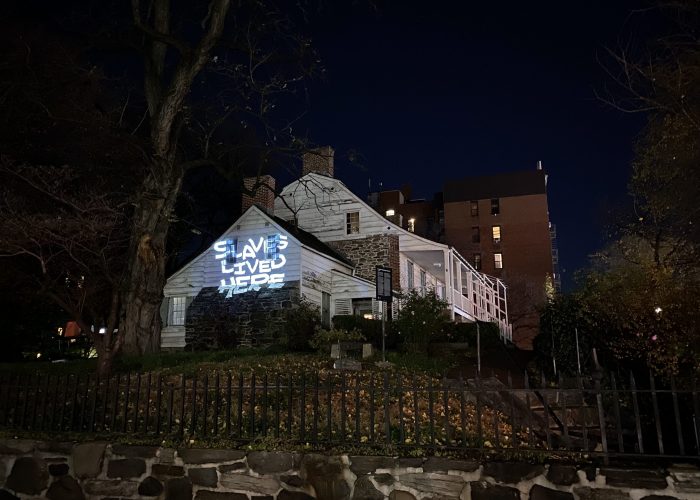The Dyckman Farmhouse Museum in Manhattans Inwood neighborhood, built in the 1780s in the Dutch Colonial style, is the oldest remaining farmhouse in New York City. It was also the home of the Dyckman family, who enslaved six people.
No Records (2020), a work by multimedia artist Reggie Black presented in collaboration with the museum, acknowledges the landmarks history of slavery by projecting the words Slaves Lived Here on the buildings façade. The message, alternating between English and Spanish to reach Inwoods predominantly Latino residents, was first projected on Monday night and will be seen again tonight from dusk until 9pm.
The history of slavery is deep in New York City, not just in the South as sometimes perceived, Black said in a statement about the project. Everyday we walk past buildings and streets named after slave owners. For us, Black people, to tell our own stories is a powerful confrontation of that history. Lets put that on display, too.
The projection alternated between the text in English and Spanish, Esclavos vivieron aquí. (photo by and courtesy of Savannah Falzarano)
As part of its DyckmanDISCOVERED initiative, made possible by a grant from the New York Community Trust, the museum hired a part-time assistant to research the lives of enslaved people who worked on the Dyckman Farm and other farms nearby. No Records is one of several works and programs presented as part of the project. On view inside the museum is the exhibition Unspoken Voices: Honoring the Legacy of Black America, featuring works by artists Gwendolyn Black, Sheila Prevost, and Rachel Sydlowski that draw from the museums architecture, history, and biographical data uncovered in the recent research.
DyckmanDISCOVERED and Blacks projection represent a reckoning for the Dyckman Farmhouse Museum and for New York at large, dispelling pervasive myths of the city as somehow excluded from the legacy of slavery in America. On its website, the organization notes that the enslaved population in New York grew faster than the white population between 1700 and 1750; by the middle of the century, New Netherland encompassing parts of the East Coast was the largest colony of enslaved people in the North.
At the Dyckman Farmhouse Museum, were both looking to the past to uncover ignored histories, and looking to the present to share this information with New Yorkers and underscore its significance, said Meredith Horsford, Executive Director of the Dyckman Farmhouse Museum Alliance. We have an obligation to shed light on the experiences of underserved and underrepresented marginalized communities.
No Records will be visible from the street at the intersection of West 204th Street and Broadway today, and Wednesday, November 9, from dusk through 9pm.
Sign up for our email newsletters!
Support Hyperallergic
As arts communities around the world experience a time of challenge and change, accessible, independent reporting on these developments is more important than ever.
Please consider supporting our journalism, and help keep our independent reporting free and accessible to all.
Become a Memberread more
Illuminating the Legacy of Slavery at a New York Museum


